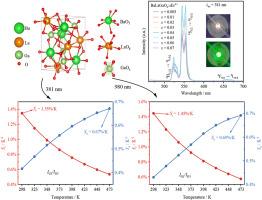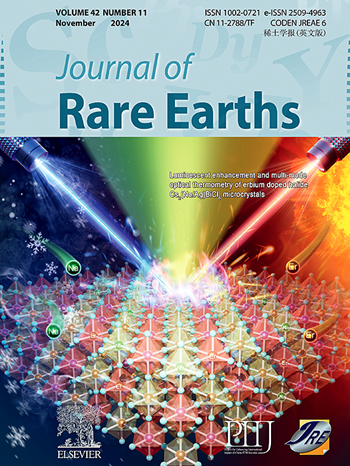Er3+ activated BaLaGaO4 multifunctional green phosphors for optical thermometers and WLEDs
IF 7.2
1区 化学
Q1 CHEMISTRY, APPLIED
引用次数: 0
Abstract
Er3+-doped BaLaGaO4 green phosphors was synthesized through a high-temperature solid-state reaction technique. The phase structure and morphology test results of the phosphor indicate that the BaLaGaO4 material was successfully synthesized and Er3+ ions were successfully doped into the main lattice. This doping does change the basic structure of the crystal. BaLaGaO4:Er3+ phosphor exhibits bright green emission centered at 545 nm when excited by 381 nm ultraviolet light or 980 nm near-infrared light. The optimal doping concentration is found to be x = 0.04. To quantify the temperature sensitivity of the phosphor, the fluorescence intensity ratio method was used. Within the temperature range of 298–473 K, the maximum relative sensitivities are 1.35%/K (298 K, 381 nm) and 1.45%/K (298 K, 980 nm), respectively. The maximum absolute sensitivities are 0.67%/K (473 K, 381 nm) and 0.69%/K (473 K, 980 nm), respectively. Finally, white light-emitting diodes (WLEDs) with a high colour index of Ra = 82 and a relatively low correlated colour temperature of CCT = 5064 K are obtained by integrating the synthesized BaLaGaO4:0.04Er3+ green phosphor into warm WLEDs devices. These results suggest that Er3+-activated BaLaGaO4 multifunctional phosphors hold considerable promise in the areas of optical temperature sensing and WLEDs phosphor conversion.

Er3+活化BaLaGaO4多功能绿色荧光粉用于光学温度计和wled
采用高温固相反应技术合成了Er3+掺杂BaLaGaO4绿色荧光粉。荧光粉的相结构和形貌测试结果表明,BaLaGaO4材料成功合成,Er3+离子成功掺杂到主晶格中。这种掺杂确实改变了晶体的基本结构。BaLaGaO4:Er3+荧光粉在381 nm紫外光或980 nm近红外光激发下,在545 nm处呈现出明亮的绿色发光。发现最佳掺杂浓度为x = 0.04。为了量化荧光粉的温度敏感性,采用荧光强度比法。在298 ~ 473 K温度范围内,最大相对灵敏度分别为1.35%/K (298 K, 381nm)和1.45%/K (298 K, 980nm)。最大绝对灵敏度分别为0.67%/K (473 K, 381 nm)和0.69%/K (473 K, 980 nm)。最后,将合成的BaLaGaO4:0.04Er3+绿色荧光粉集成到暖色wled器件中,获得了高显色指数Ra = 82、低相关色温CCT = 5064 K的白光发光二极管(wled)。这些结果表明,Er3+激活的BaLaGaO4多功能荧光粉在光学温度传感和wled荧光粉转换领域具有相当大的前景。
本文章由计算机程序翻译,如有差异,请以英文原文为准。
求助全文
约1分钟内获得全文
求助全文
来源期刊

Journal of Rare Earths
化学-应用化学
CiteScore
8.70
自引率
14.30%
发文量
374
审稿时长
1.7 months
期刊介绍:
The Journal of Rare Earths reports studies on the 17 rare earth elements. It is a unique English-language learned journal that publishes works on various aspects of basic theory and applied science in the field of rare earths (RE). The journal accepts original high-quality original research papers and review articles with inventive content, and complete experimental data. It represents high academic standards and new progress in the RE field. Due to the advantage of abundant RE resources of China, the research on RE develops very actively, and papers on the latest progress in this field emerge every year. It is not only an important resource in which technicians publish and obtain their latest research results on RE, but also an important way of reflecting the updated progress in RE research field.
The Journal of Rare Earths covers all research and application of RE rare earths including spectroscopy, luminescence and phosphors, rare earth catalysis, magnetism and magnetic materials, advanced rare earth materials, RE chemistry & hydrometallurgy, RE metallography & pyrometallurgy, RE new materials, RE solid state physics & solid state chemistry, rare earth applications, RE analysis & test, RE geology & ore dressing, etc.
 求助内容:
求助内容: 应助结果提醒方式:
应助结果提醒方式:


